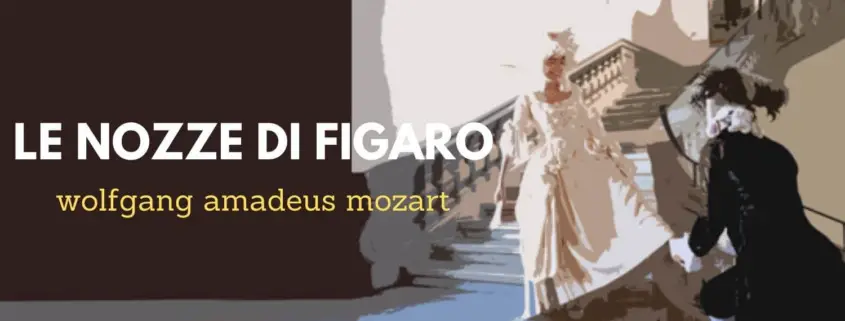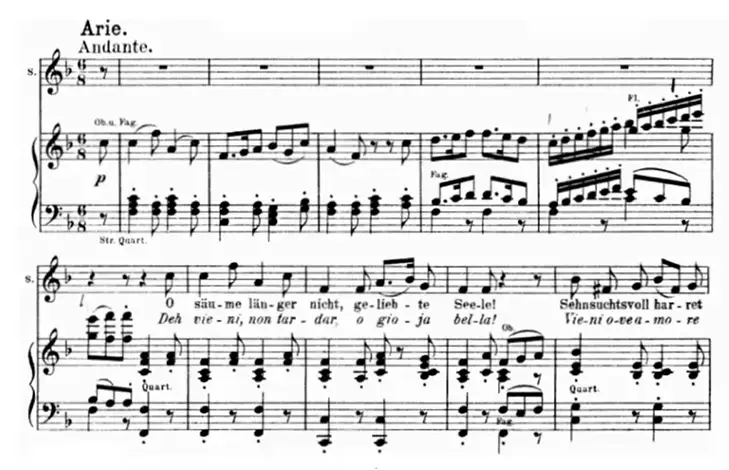DEH NON VIENI TARDAR – the aria of from the opera Le nozze di figaro
The online opera guide to Mozart’s aria DEH NON VIENI TARDAR
Read Interesting facts and hear great YouTube Videos about the famous Aria “DEH NON VIENI TARDAR” (the aria of roses).
The Aria – synopsis and background
Synopsis: In the castle of Count Almaviva. The servants Figaro and Susanna plan their marriage. Figaro has learned that his future wife has a date with the count. He is outraged and decides to secretely follow her to observe the date. But the whole thing is a ruse to outsmart the count, Susanna disguises herself as the countess. Susanna knows that Figaro is hiding behind the bushes and the aria is a declaration of love to him.
Susanna’s rose aria (“Deh non vieni tardar”) unfolds in a swaying rhythm, accompanied by strings and woodwinds. It is a beautiful, lyrical declaration of love to her future husband Figaro, and the utopia of a world in which there are no more differences in class. The aria is a great quiet point of the opera.
The oboe and bassoon introduce and play the theme of the aria. It’s setting is a warm and calm summer evening in the garden of the count’s castle. The rose aria of Susanna (“Deh non vieni tardar”) unfolds in a swaying rhythm and accompanied by strings and woodwinds:
The voice must flow in the best legato, it is the temptation to Figaro to come out of the darkness to her lover and enjoy the pleasures of love. With a beautiful upward movement of the woodwinds, Susanna’s voice swings to a celestial A:
Mozart wrote this aria for the English soprano Nancy Storace who was his first Susanna. She is said to have problems with the high notes at the time. Therefore Mozart composed the aria in the lower range of the soprano pitch, so that in our days some singers sing single notes an octave higher.
The Aria – the text of DEH NON VIENI TARDAR
Recitativo:
Giunse alfin il momento
che godrò senz’affanno
in braccio all’idol mio. Timide cure,
uscite dal mio petto,
a turbar non venite il mio diletto!
Oh, come par che all’amoroso foco
l’amenità del loco,
la terra e il ciel risponda,
come la notte i furti miei seconda!
Aria:
Deh, vieni, non tardar, oh gioia bella,
vieni ove amore per goder t’appella,
finché non splende in ciel notturna face,
finché l’aria è ancor bruna e il mondo tace.
Qui mormora il ruscel, qui scherza l’aura,
che col dolce sussurro il cor ristaura,
qui ridono i fioretti e l’erba è fresca,
ai piaceri d’amor qui tutto adesca.
Vieni, ben mio, tra queste piante ascose,
ti vo’ la fronte incoronar di rose.
Recitativo:At last comes the moment
When, without reserve, I can rejoice
In my lover’s arms: timid scruples,
Hence from my heart,
And do not come to trouble my delight.
Oh how the spirit of this place,
The earth and the sky, seem
To echo the fire of love!
How the night furthers my stealth!Aria:Come, do not delay, oh bliss,
Come where love calls thee to joy,
While night’s torch does not shine in the sky,
While the air is still dark and the world quiet.
Here murmurs the stream, here sports the breeze,
Which refreshes the heart with its sweet whispers.
Here flowers smile and the grass is cool;
Here everything invites to the pleasures of love.
Come, my dearest, and amid these sheltered trees
I will wreathe thy brow with roses.
Written for a “lyrical soprano”
The role of Susanna is written for a lyrical soprano. The lyrical soprano must have a voice with a warm timbre and must be able to convince with a bell-like sound in the high register. This should be colourful and must not sound forced. The middle register must be rich.
Famous interpretations of DEH NON VIENI TARDAR
The aria has been sung only by a few as intimately as by Lucia Popp. The voice is crystal clear and natural and full of feeling. The “Vieni” and “incoronar” are beautifully romantically sung.
Deh vieni non tardar (Aria of the roses) (1) – Popp
You will hear another beautiful interpretation by Barbara Bonney. The Canadian and became famous as the singer of the title song of Steven Spielberg’s “AI, Artificial Intelligence”. Listen to her “Deh non vieni tardar”.
Deh vieni non tardar (Aria of the roses) (2) – Bonney
The Susanna is one of Diana Damrau’s key roles. Her comedic talent (see for example the “Via resti servita, madama brillante” in the opera portrait) paired with her beautiful voice make her a highlight of this opera.
Deh vieni non tardar (Aria of the roses) (3) – Damrau
Susanna was also one of the most important roles of the American coloratura soprano Kathleen Battle. You will hear an ethereal Susanna whose voice shines with brightly sung out passages. This recording brings out the beautiful voice of the Battle, but the tempo is clearly too slow. The orchestra is barely audible and the beautiful swaying pizzicato accompaniment, which creates the romantic evening mood, is missing. It is the performance of a diva.
Deh vieni non tardar (Aria of the roses) (4) – Battle
Peter Lutz, opera-inside, the online opera guide to the Aria “DEH NON VIENI TARDAR”” from the opera Le nozze di figaro.





Leave a Reply
Want to join the discussion?Feel free to contribute!